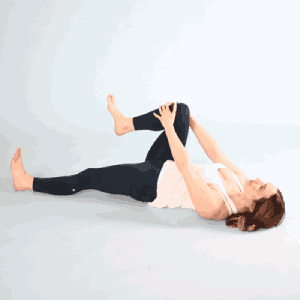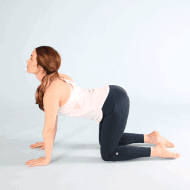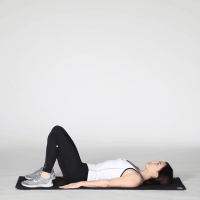Lumbar spinal stenosis is a pretty common condition that affects millions of people, especially in their old age. It occurs when the spinal canal narrows, putting pressure on the nerves within the lumbar region of the spine. This pressure can lead to a range of symptoms, such as lower back pain, leg pain, and numbness. In this blog, we are going to delve into lumbar spinal stenosis, its causes, and the various treatment options available to manage this condition effectively.
Contents
What Exactly Is Lumbar Spinal Stenosis?%22%20transform%3D%22translate(.6%20.6)%20scale(1.17188)%22%20fill-opacity%3D%22.5%22%3E%3Cellipse%20fill%3D%22%23e9e9e9%22%20rx%3D%221%22%20ry%3D%221%22%20transform%3D%22rotate(132.1%2047.1%2091.8)%20scale(81.66782%2058.95263)%22%2F%3E%3Cellipse%20fill%3D%22%231b1b1b%22%20rx%3D%221%22%20ry%3D%221%22%20transform%3D%22matrix(252.45603%20-35.92981%204.85214%2034.09292%20102.5%2019.5)%22%2F%3E%3Cellipse%20fill%3D%22%23363636%22%20cx%3D%2226%22%20cy%3D%2252%22%20rx%3D%2257%22%20ry%3D%2257%22%2F%3E%3Cellipse%20fill%3D%22%238a8a8a%22%20rx%3D%221%22%20ry%3D%221%22%20transform%3D%22rotate(-92.6%2084%20-41.4)%20scale(20.79583%2072.34634)%22%2F%3E%3C%2Fg%3E%3C%2Fsvg%3E)
Lumbar spinal stenosis is a medical condition characterized by the narrowing of the spinal canal in the lower back, specifically in the lumbar region of the spine. The spinal canal is the hollow space that houses the spinal cord and nerve roots. When this canal narrows, it can put pressure on the spinal cord and nerves, leading to various symptoms and discomfort.
Causes of Lumbar Spinal Stenosis:
The narrowing of the spinal canal in lumbar spinal stenosis can occur for several reasons, including:
- Aging: One of the most common causes is the natural aging process. As people get older, the ligaments of the spine may thicken and harden, and the discs between the vertebrae may lose fluid and height. These changes can contribute to spinal canal narrowing.
- Herniated Discs: When the soft inner material of a spinal disc pushes through its tough outer shell, it can protrude into the spinal canal, leading to stenosis.
- Bone Spurs: Over time, the body may respond to the changes in the spine by growing extra bone. These bone spurs, also known as osteophytes, can intrude into the spinal canal and cause narrowing.
- Arthritis: Degenerative changes associated with conditions like osteoarthritis and rheumatoid arthritis can lead to the development of bone spurs, thickened ligaments, and other factors contributing to stenosis.
It’s important to note that lumbar spinal stenosis can progress gradually over time, and the severity of symptoms may vary among individuals. Treatment options, which may include physical therapy, medications, injections, or surgery, depend on the specific circumstances and symptoms of each patient. If you suspect you have lumbar spinal stenosis, consult with a healthcare provider for a proper diagnosis and personalized treatment plan.
Exercises For Lumbar Spinal Stenosis
Exercise plays a crucial role in managing lumbar spinal stenosis by improving flexibility, strengthening the supporting muscles, and promoting better posture. However, it’s essential to consult with a healthcare provider or physical therapist before starting any exercise program. Here are some exercises that may help alleviate symptoms of lumbar spinal stenosis:
Pelvic Tilts
- How to Do It:
- Lie on your back with your knees bent and feet flat on the floor.
- Tighten your abdominal muscles and push your lower back into the floor.
- Hold for 5-10 seconds, then relax.
- Repeat this movement 10-15 times.
- Benefits: Pelvic tilts strengthen your abdominal muscles and help maintain a neutral spine position, reducing lower back strain.
Knee-to-Chest Stretch
- How to Do It:
- Lie on your back with your knees bent and feet flat on the floor.
- Gently bring one knee toward your chest and hold it with both hands.
- Hold the stretch for 15-30 seconds.
- Release and switch to the other leg.
- Repeat 2-4 times for each leg.
- Benefits: This stretch can help relieve tension in the lower back and reduce sciatica pain associated with lumbar spinal stenosis.
Cat-Cow Stretch
- How to Do It:
- Begin on your hands and knees in a tabletop position.
- Inhale as you arch your back (cow pose) and lift your head and tailbone.
- Exhale as you round your back (cat pose) and tuck your chin toward your chest.
- Repeat these movements 10-15 times.
- Benefits: The cat-cow stretch helps improve spinal flexibility and reduce stiffness in the lower back.
Bridge Exercise
- How to Do It:
- Lie on your back with your knees bent and feet flat on the floor.
- Tighten your glutes and lift your hips off the ground, creating a straight line from your shoulders to your knees.
- Hold the bridge position for 5-10 seconds, then lower your hips.
- Repeat this exercise 10-15 times.
- Benefits: Bridges strengthen the muscles of the lower back, buttocks, and core, providing better support to the lumbar spine.
Seated Hamstring Stretch
- How to Do It:
- Sit on the edge of a chair with your feet flat on the floor.
- Extend one leg straight in front of you.
- Lean forward from your hips, reaching toward your toes.
- Hold the stretch for 15-30 seconds on each leg.
- Repeat 2-4 times for each leg.
- Benefits: This stretch helps improve flexibility in the hamstrings and lower back, reducing pressure on the lumbar spine.
Water Aerobics
- Water aerobics can be an excellent low-impact exercise option for individuals with lumbar spinal stenosis. The buoyancy of the water reduces the impact on the joints while providing resistance for muscle strengthening.
Effective Treatment Options For Lumbar Spinal Stenosis%27%20fill-opacity%3D%27.5%27%3E%3Cellipse%20fill%3D%22%23088c99%22%20fill-opacity%3D%22.5%22%20rx%3D%221%22%20ry%3D%221%22%20transform%3D%22rotate(-84.5%2088%2075.5)%20scale(68.3004%2052.44467)%22%2F%3E%3Cellipse%20fill%3D%22%23fff7f8%22%20fill-opacity%3D%22.5%22%20rx%3D%221%22%20ry%3D%221%22%20transform%3D%22matrix(41.21834%2012.83808%20-22.26183%2071.47451%20150%20.6)%22%2F%3E%3Cellipse%20fill%3D%22%23fffdfe%22%20fill-opacity%3D%22.5%22%20rx%3D%221%22%20ry%3D%221%22%20transform%3D%22matrix(28.45919%2021.98644%20-33.37714%2043.20328%20299.4%20156.4)%22%2F%3E%3Cellipse%20fill%3D%22%2354c6b7%22%20fill-opacity%3D%22.5%22%20rx%3D%221%22%20ry%3D%221%22%20transform%3D%22matrix(-43.67567%2025.94492%20-28.85581%20-48.57586%20175.3%20176)%22%2F%3E%3C%2Fg%3E%3C%2Fsvg%3E)
Lumbar spinal stenosis, a condition characterized by the narrowing of the spinal canal in the lower back, can be challenging to manage. However, several effective treatment options are available to alleviate symptoms and improve the quality of life for those affected. Here are the primary treatment options for lumbar spinal stenosis:
- Physical Therapy: It is often a fundamental component of lumbar spinal stenosis treatment. Skilled physical therapists design customized exercise programs to strengthen the muscles supporting the spine, enhance flexibility, and teach proper posture and body mechanics. It aims to reduce pain, enhance mobility, and improve overall function, allowing individuals to regain control over their daily activities.
- Medications: Over-the-counter pain relievers like ibuprofen or acetaminophen can help manage mild pain. For more severe pain, healthcare providers may prescribe muscle relaxants or anti-seizure medications.
- Epidural Steroid Injections: Corticosteroid injections into the area around the spinal cord can reduce inflammation and alleviate pain associated with nerve compression. They can also provide temporary relief, allowing individuals to participate in rehabilitation and other therapeutic interventions more effectively.
- Assistive Devices: Some individuals benefit from assistive devices such as canes or walkers. These devices support mobility and reduce the pressure on the spine during weight-bearing activities. These devices enhance stability and help individuals maintain their independence.
- Surgical Interventions: In cases where conservative treatments are ineffective or when there’s a risk of permanent nerve damage, surgery may be necessary. Common surgical procedures include laminectomy (removal of part of the vertebral bone to relieve pressure), spinal fusion, or minimally invasive techniques.
- Lifestyle Modifications: Making lifestyle changes such as maintaining a healthy weight, staying physically active, and avoiding activities that exacerbate symptoms can help manage lumbar spinal stenosis. These changes can contribute to improved overall health and well-being, reducing the impact of the condition on daily life.
Preventing And Managing Flare-Ups Of Lumbar Spinal Stenosis
Here are some key steps to help prevent and handle flare-ups of lumbar spinal stenosis:
- Maintain a Healthy Lifestyle: Engaging in a structured exercise program prescribed by a physical therapist can strengthen supporting muscles and improve spinal flexibility. Regular exercise can help reduce the risk of flare-ups. Apart from that excess weight puts additional stress on the spine. Maintaining a healthy weight through a balanced diet and exercise can alleviate pressure on the lumbar region.
- Practice Good Posture: Pay attention to your posture when sitting, standing, or lifting objects. Using ergonomic furniture and equipment can reduce the strain on your spine. When lifting heavy objects, use your legs to lift rather than your back. Bend your knees and keep the object close to your body to minimize strain on the lumbar area.
- Ergonomic Changes: If you have a desk job, make ergonomic adjustments to your workspace, such as using an ergonomic chair and keyboard, to minimize strain on your lower back.
- Regular Check-Ups: Regular follow-up appointments can help monitor your condition and make necessary adjustments to your treatment plan.
- Avoid High-Impact Activities: Avoid high-impact sports or activities that can exacerbate your condition, especially during flare-ups.
- Rest and Relaxation: When you experience a flare-up, allow yourself adequate rest and avoid activities that worsen your symptoms.
- Cold and Heat Therapy: Depending on your preference and what provides relief, use cold packs or heating pads to alleviate pain and inflammation during flare-ups.
Conclusion
Lumbar spinal stenosis is a condition that affects many individuals, causing discomfort and limiting mobility. However, with the right approach, it is possible to manage the symptoms effectively and improve one’s quality of life. Whether through physical therapy, medication, lifestyle adjustments, or surgical interventions, there are options available to address lumbar spinal stenosis. While lumbar spinal stenosis can present challenges, it is possible to regain control over daily activities, find relief from pain, and lead a fulfilling life by staying informed, seeking professional guidance, and implementing a comprehensive approach to management.
If you’re experiencing Back pain, physical therapy for back pain at PhysioMantra can help: Book an online physical therapy session.











